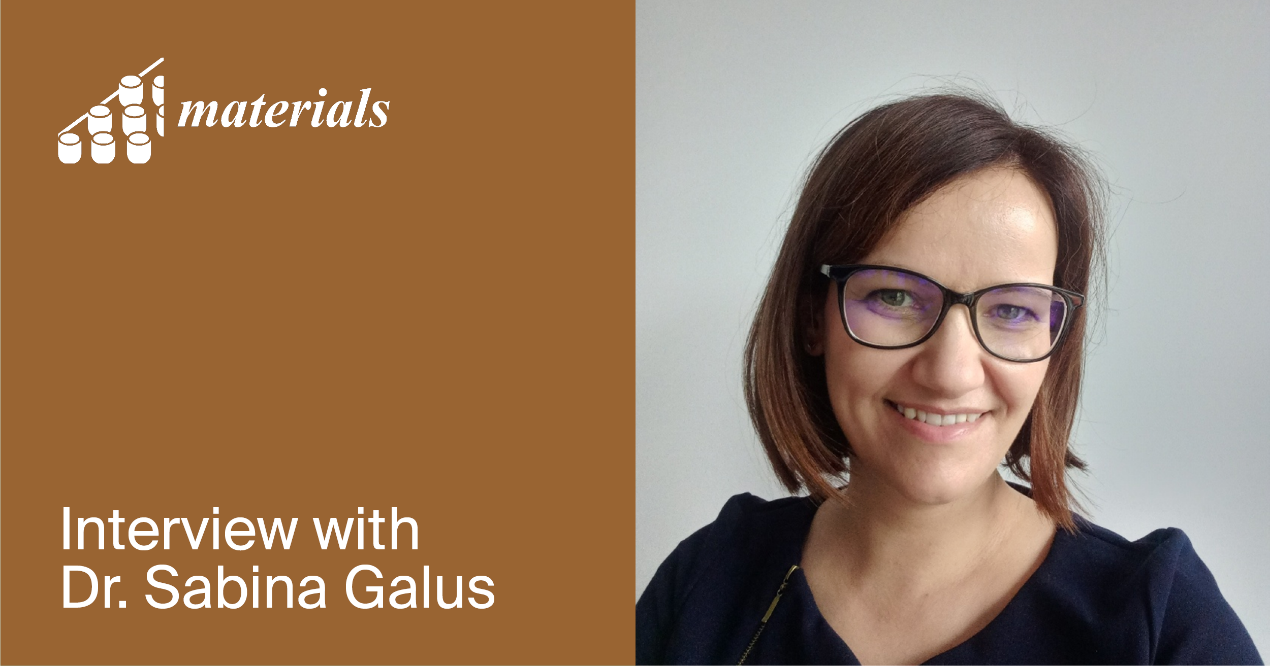Need Help?
27 October 2025
Materials | Interview with the Issue Cover Author—Dr. Sabina Galus

Dr. Sabina Galus is one of the corresponding authors of the Volume 18, Issue 16’s Cover Paper entitled “The Effects of Gamma-Decalactone on the Physicochemical and Antimicrobial Properties of Pectin-Based Packaging Films” published in Materials (ISSN: 1996-1944).
Dr. Sabina Galus completed her PhD in food science and technology at the Warsaw University of Life Sciences, Poland. Her research interests include food packaging, food coating, and new food product development. Dr. Galus has experience developing bio-based active and intelligent packaging materials for food applications. Currently, her work focuses on the study of novel functional and sustainable materials, such as films or pouch packaging, and circular food products.
Based on the positive evaluations by the reviewers and academic editors for Dr. Sabina Galus’s group article, we have selected their article as the Issue Cover for display on the Materials website.

by Gabriela Kozakiewicz, Jolanta Małajowicz, Magdalena Karwacka, Agnieszka Ciurzyńska, Karolina Szulc, Anna Żelazko, Monika Janowicz and Sabina Galus
Materials 2025, 18(16), 3831; https://doi.org/10.3390/ma18163831
The following is an interview with Dr. Sabina Galus:
1. Congratulations on your published paper. Could you please briefly introduce the main research content of the published paper?This paper focuses on an innovative strategy for active, biodegradable food packaging through the incorporation of gamma-decalactone (GDL), a natural aromatic compound with antimicrobial properties, into apple-pectin-based edible films. The addition of GDL significantly modified the film structure, resulting in enhanced light barrier properties, a more porous microstructure (confirmed by SEM), and reduced tensile strength. The films also exhibited lower water vapour sorption and increased gas permeability. Fourier transform infrared spectroscopy analysis confirmed interactions between GDL and the polymer matrix. The films with GDL exhibited antimicrobial properties against various microbial species, including bacteria, yeasts, and moulds. These results highlight GDL’s dual function as a natural aromatic and antimicrobial agent, supporting its potential application in sustainable packaging for perishable foods.
2. What are the key takeaways that you hope readers will gain from your paper?Readers should have a clear indication that the incorporation of aromatic compounds, such as gamma-decalactone, may not only affect the odour of the packaging material but also provide functional aspects such as antimicrobial effects and modified physical properties. However, these results require further research regarding practical applications for food.
3. Was there a specific experience or event in your research career that led you to focus on your current field of research?Edible packaging, a new research area for my PhD thesis, prompted me to seek opportunities for acquiring new analytical techniques and sharing expertise beyond the University. Consequently, I spent six months at the University of Burgundy, France, during my PhD research, focusing on bio-based packaging. This supportive stay, along with other collaborations with researchers from various institutions, significantly influenced my current interests and underscored the importance of sustainable food packaging research.
4. How do you evaluate research trends in this field, and what advice would you give to other young researchers?Numerous studies address novel packaging materials, a clear response to environmental concerns regarding packaging waste management. I focus on innovations in food packaging, particularly active materials that may influence food quality and safety. My current research encountered significant challenges in optimising biopolymer-based material formulations. The goal is to ensure structural integrity while achieving desired functional properties, such as antioxidant, antimicrobial or intelligent response. The main aspects we should consider are the practical application of new materials and their potential future use.
5. What is your experience publishing with Materials?My publishing experience with Materials has been positive. The submission process was suitable, and the editorial team was responsive and helpful. The precise peer-review process ensured the quality of the work. Additionally, the publication’s visibility and reach effectively disseminated my research to a broader audience. Overall, it has been a rewarding experience, facilitating the contribution of two papers to the field.
6. How do you think open access publishing impacts authors?In my opinion, open access publishing impacts authors by increasing the visibility and potential impact of their work. It makes papers more accessible to a global audience, potentially leading to higher citations and affecting the possibility of collaboration with other researchers.

